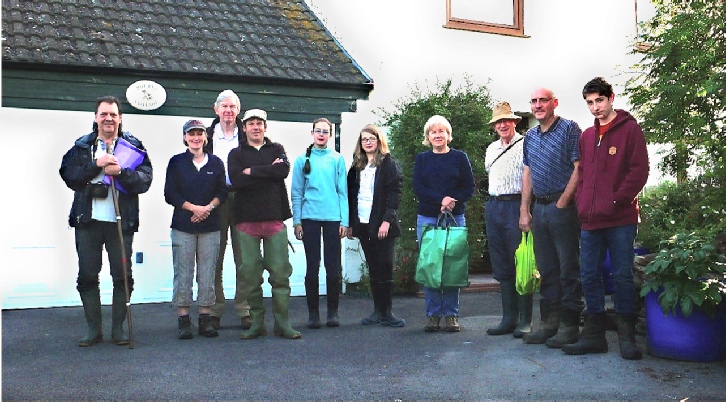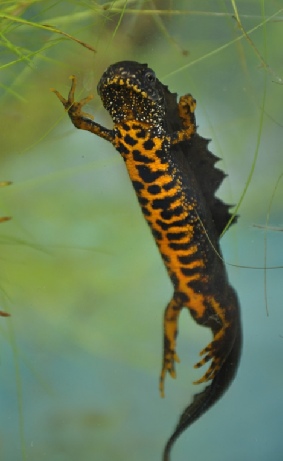


A few days later a female GCN came out from an old weed pile, and not so far from that several GCN larvae were discovered in a water pool. It pays to be observant when out and about.
It’s been a long time since formal ‘community’ surveys were done on local ponds, so such work is desperately overdue.
Some prospective developers have recently had to carry out surveys for GCNs because they are a protected species. Their results show they are still present and ‘hanging on’; but only just.
Although GCNs can still be found in some areas of Eastington, their numbers are very low. This is probably due to their main breeding ponds becoming overgrown, or running dry after egg laying.
A significant amount of maintenance is well overdue, and it’s hoped that volunteers of PAWS can help with this need. Following our first survey, a landowner has kindly agreed for some maintenance to be done on a key pond. Maintenance should help amphibians breed successfully again, and future surveying will measure the success our work.
Although we have started in the south of Eastington, as we gain members and skills our intention is to expand to survey ponds in other parts of Eastington. If you are interested in joining us please contact me.
Andrew Niblett | 01453 824841

The newly formed Eastington community group for wetland plants and animals has yet to formally finalise its name, but PAWS will do for now - Plants & Animals in Wetlands Society.
Water is rarely very far below our feet in the lower parts of Eastington, which may explain the abundance of old ponds and damp places about us.
Whilst we may prefer warm dry places, many creatures thrive in damp or wet places. Modern-day pressures on our time, and calls for increased efficiency, have lead to a decline in the number of ponds and ‘natural’ places for water-loving creatures. So, it’s important to safeguard sufficient places to ensure their survival.
Ponds are of course vital to amphibians, but so too are the ditches and watercourses that drain the land. Also important are the refuges of piles of stones or wood, garden ponds, and the bottoms of hedgerows.
Great Crested Newts (GCN) are the most well-known and high profile amphibian in this area due to them being a protected species.
An interest in the creatures that live in the ponds, ditches and other wet places has grown on several of us during the time we have lived in Eastington, and we decided to invite others to join us to investigate.
Eleven of us met on Friday evening, 26th June with Richard and John of Stroud Valleys Project [both licenced to handle GCNs,] to lay some newt traps.
Bright and early at 07:30 the following morning [pictured,] we returned to check and clear the traps. The weather was perfect and it was a very enjoyable first meeting of the group. We were lucky to find a male Smooth Newt in one of the traps, as we were late in the surveying season. Of course, we released it straight away after everyone had a close-up look at it.
We learned some new ideas for pond maintenance work needed to prepare for surveying next season.
Great Crested Newt
Triturus Cristatus (from the Greek Triton a demigod of the sea, and the Latin for Crested)
The Great Crested Newt is dark grey-brown or black with a warty, rough skin. The underside is either yellow or orange with large black spots and the sides are stippled with tiny white dots. Males have a jagged crest that runs along their backs, more pronounced during the breeding season, dipping at the rear of the abdomen to a smoother-edged crest above and below the tail. It lies flat to the body when the newt is out of water.
Females lack a crest and have a yellow-orange streak along the bottom of their tails.
Great Crested grow to about 17 cm long and can reach an age of 27 years. They overwinter in scrub woodland and live in large ponds and slow moving streams from March to September.
Smooth Newt,
Common Newt Triturus vulgaris
These also have a crest (but less impressive!) during the breeding season, grow only to about 10 cm and are nocturnal, spending the day hiding under large stones or compost heaps.



Palmate Newt Triturus helveticus
The male also has a crest during the breeding season but it is straight-edged and much less obvious than the smooth newt’s. They also have a short filament at the end of the tail and have webbed hind feet.




| District council Newsletter |
| Village Agent |
| Bath Road |
| Local Plan |
| Nbhd Development plan(NDP) |
| Eastington Primary School |
| St Michaels Anglican Church |
| Eastington Methodist Church |
| Citizens Advice Bureau |
| EARS (Road Safety) |
| ecn magazine |
| E.C.Orchard Group. |
| Slimming World |
| Jolly Joggers |
| PAWS |
| PROWD (footpaths) |
| Madge of Millend |
| Bee Keepers Diary |
| PAWS (wetland survey) |
| Autumn Flower Show |
| Advertisements |
| Puzzle Page |